Rehabilitation Nursing Practice for Stroke Patients
VerifiedAdded on 2023/04/20
|11
|3350
|441
AI Summary
This essay analyzes the importance and implications of rehabilitation nursing practice for stroke patients in the neurological domain. It discusses the causes of stroke, presenting features, effects on individuals, anatomy and physiological relevance, neurological functioning, and rehabilitation programs. The essay emphasizes the need for patient engagement and customized rehabilitation programs to improve outcomes.
Contribute Materials
Your contribution can guide someone’s learning journey. Share your
documents today.
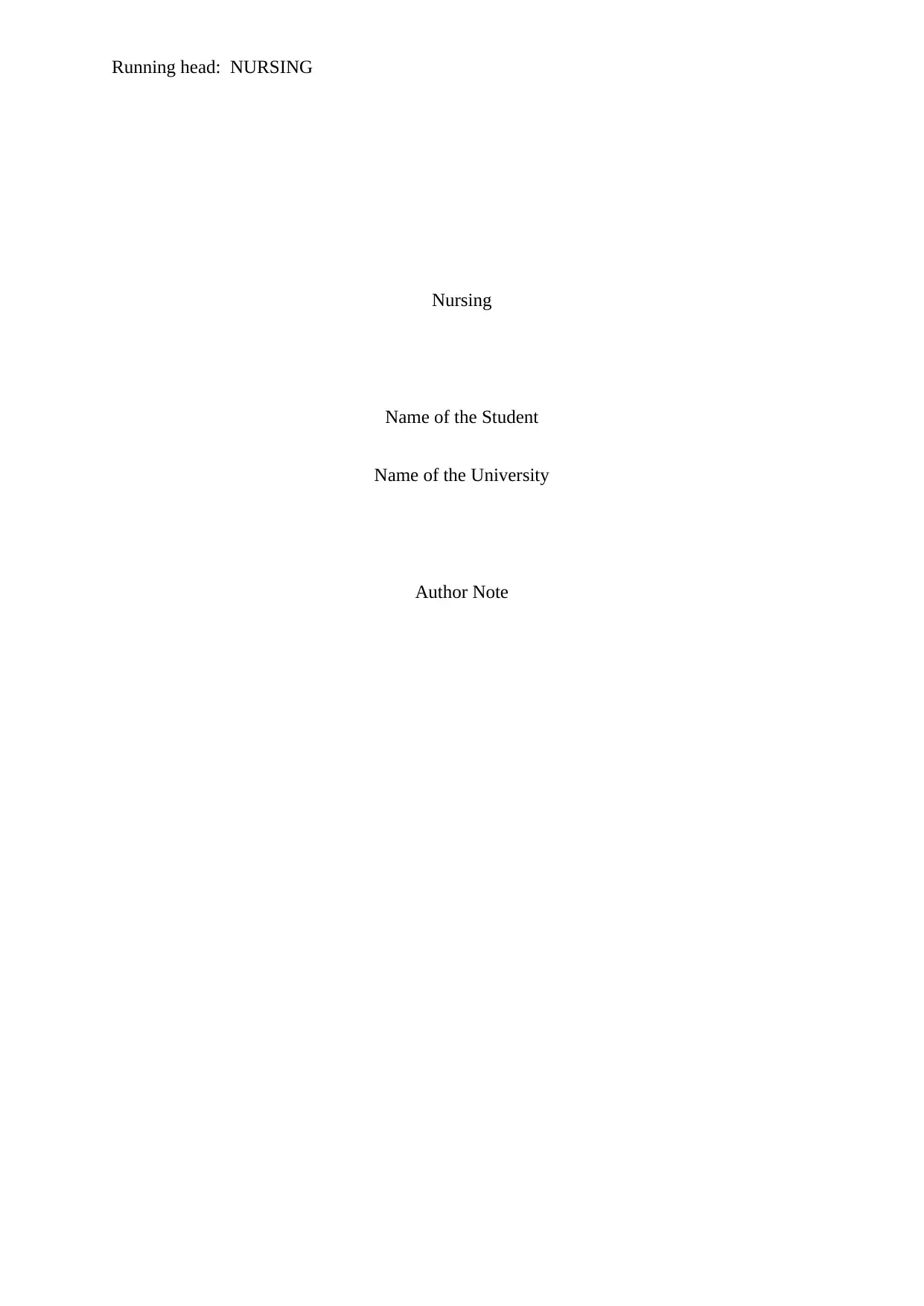
Running head: NURSING
Nursing
Name of the Student
Name of the University
Author Note
Nursing
Name of the Student
Name of the University
Author Note
Secure Best Marks with AI Grader
Need help grading? Try our AI Grader for instant feedback on your assignments.
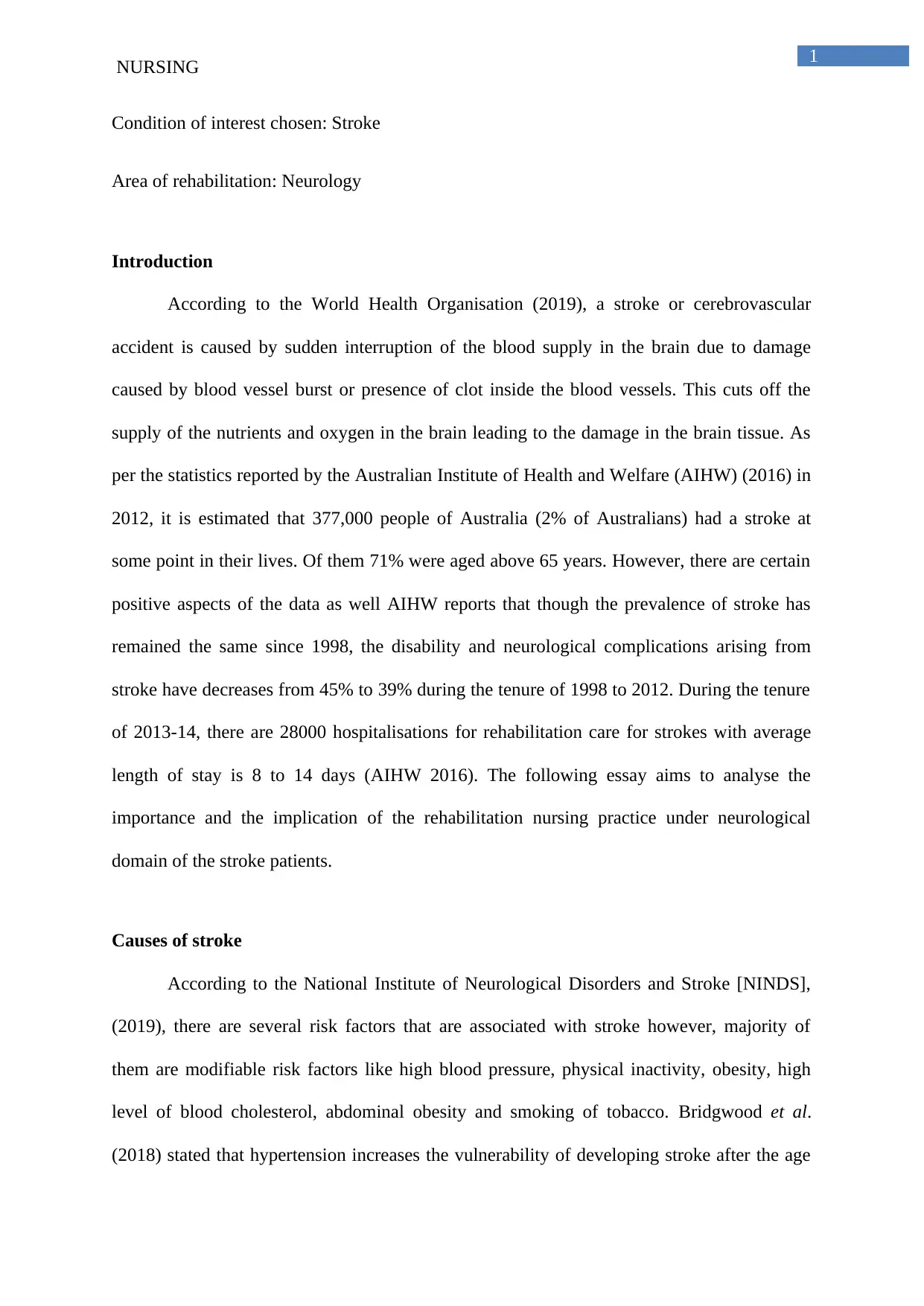
1
NURSING
Condition of interest chosen: Stroke
Area of rehabilitation: Neurology
Introduction
According to the World Health Organisation (2019), a stroke or cerebrovascular
accident is caused by sudden interruption of the blood supply in the brain due to damage
caused by blood vessel burst or presence of clot inside the blood vessels. This cuts off the
supply of the nutrients and oxygen in the brain leading to the damage in the brain tissue. As
per the statistics reported by the Australian Institute of Health and Welfare (AIHW) (2016) in
2012, it is estimated that 377,000 people of Australia (2% of Australians) had a stroke at
some point in their lives. Of them 71% were aged above 65 years. However, there are certain
positive aspects of the data as well AIHW reports that though the prevalence of stroke has
remained the same since 1998, the disability and neurological complications arising from
stroke have decreases from 45% to 39% during the tenure of 1998 to 2012. During the tenure
of 2013-14, there are 28000 hospitalisations for rehabilitation care for strokes with average
length of stay is 8 to 14 days (AIHW 2016). The following essay aims to analyse the
importance and the implication of the rehabilitation nursing practice under neurological
domain of the stroke patients.
Causes of stroke
According to the National Institute of Neurological Disorders and Stroke [NINDS],
(2019), there are several risk factors that are associated with stroke however, majority of
them are modifiable risk factors like high blood pressure, physical inactivity, obesity, high
level of blood cholesterol, abdominal obesity and smoking of tobacco. Bridgwood et al.
(2018) stated that hypertension increases the vulnerability of developing stroke after the age
NURSING
Condition of interest chosen: Stroke
Area of rehabilitation: Neurology
Introduction
According to the World Health Organisation (2019), a stroke or cerebrovascular
accident is caused by sudden interruption of the blood supply in the brain due to damage
caused by blood vessel burst or presence of clot inside the blood vessels. This cuts off the
supply of the nutrients and oxygen in the brain leading to the damage in the brain tissue. As
per the statistics reported by the Australian Institute of Health and Welfare (AIHW) (2016) in
2012, it is estimated that 377,000 people of Australia (2% of Australians) had a stroke at
some point in their lives. Of them 71% were aged above 65 years. However, there are certain
positive aspects of the data as well AIHW reports that though the prevalence of stroke has
remained the same since 1998, the disability and neurological complications arising from
stroke have decreases from 45% to 39% during the tenure of 1998 to 2012. During the tenure
of 2013-14, there are 28000 hospitalisations for rehabilitation care for strokes with average
length of stay is 8 to 14 days (AIHW 2016). The following essay aims to analyse the
importance and the implication of the rehabilitation nursing practice under neurological
domain of the stroke patients.
Causes of stroke
According to the National Institute of Neurological Disorders and Stroke [NINDS],
(2019), there are several risk factors that are associated with stroke however, majority of
them are modifiable risk factors like high blood pressure, physical inactivity, obesity, high
level of blood cholesterol, abdominal obesity and smoking of tobacco. Bridgwood et al.
(2018) stated that hypertension increases the vulnerability of developing stroke after the age

2
NURSING
of 65. Cigarette smoking increase the vulnerability of developing ischemic stroke and
hemorrhagic stroke and is linked with the development of the fatty substances in the carotid
arteries or neck arteries (arthrosclerosis) that supply blood to the brain. Blockage of these
arteries leads to stroke. Hypercholesterolemia also leads to the development of arthrosclerosis
leading to stroke. Lifestyle changes can help to work on the modifiable risk factors of stroke.
Diabetes, a fatal non-communicable disease or lifestyle disease also increases the chance of
developing stroke during the later stages of life by increase the deposition of the cholesterol
in the arteries (artherosclerosis) leading to the stroke (Arboix 2015). The non-modifiable risk
factors of stroke include rage, gender, and race, family history of stroke or cardiovascular
problems. Common cardiovascular problems that lead to stroke include coronary artery
disease, irregular heartbeats (atrial fibrillation), valve defects and enlargement of the one of
the heart’s chamber leading to formation of clots (NINDS 2019).
Presenting features of stroke
The main presenting features of stroke include sudden numbness or weakness in arm,
face or leg of one side of the body, mainly left side and sudden confusion or trouble in
communication or understanding speech. Some people experience trouble in vision, walking
or loss of balance of the body along with head-ache. Other danger signs care characterised
with double vision, vomiting nausea. The majority of these signs appear for a few moments
and then disappear; these brief transitions are popularly known as “mini-strokes” or transient
ischemic attacks (NINDS 2019).
Effect of stroke on individual
Sullivan et al. (2013) stated that numerous conditions surface after stroke. Majority of
them are common and improve during the course of time and rehabilitation. It is required to
remain aware about the common effect of stroke in order to promote a comprehensive disease
NURSING
of 65. Cigarette smoking increase the vulnerability of developing ischemic stroke and
hemorrhagic stroke and is linked with the development of the fatty substances in the carotid
arteries or neck arteries (arthrosclerosis) that supply blood to the brain. Blockage of these
arteries leads to stroke. Hypercholesterolemia also leads to the development of arthrosclerosis
leading to stroke. Lifestyle changes can help to work on the modifiable risk factors of stroke.
Diabetes, a fatal non-communicable disease or lifestyle disease also increases the chance of
developing stroke during the later stages of life by increase the deposition of the cholesterol
in the arteries (artherosclerosis) leading to the stroke (Arboix 2015). The non-modifiable risk
factors of stroke include rage, gender, and race, family history of stroke or cardiovascular
problems. Common cardiovascular problems that lead to stroke include coronary artery
disease, irregular heartbeats (atrial fibrillation), valve defects and enlargement of the one of
the heart’s chamber leading to formation of clots (NINDS 2019).
Presenting features of stroke
The main presenting features of stroke include sudden numbness or weakness in arm,
face or leg of one side of the body, mainly left side and sudden confusion or trouble in
communication or understanding speech. Some people experience trouble in vision, walking
or loss of balance of the body along with head-ache. Other danger signs care characterised
with double vision, vomiting nausea. The majority of these signs appear for a few moments
and then disappear; these brief transitions are popularly known as “mini-strokes” or transient
ischemic attacks (NINDS 2019).
Effect of stroke on individual
Sullivan et al. (2013) stated that numerous conditions surface after stroke. Majority of
them are common and improve during the course of time and rehabilitation. It is required to
remain aware about the common effect of stroke in order to promote a comprehensive disease
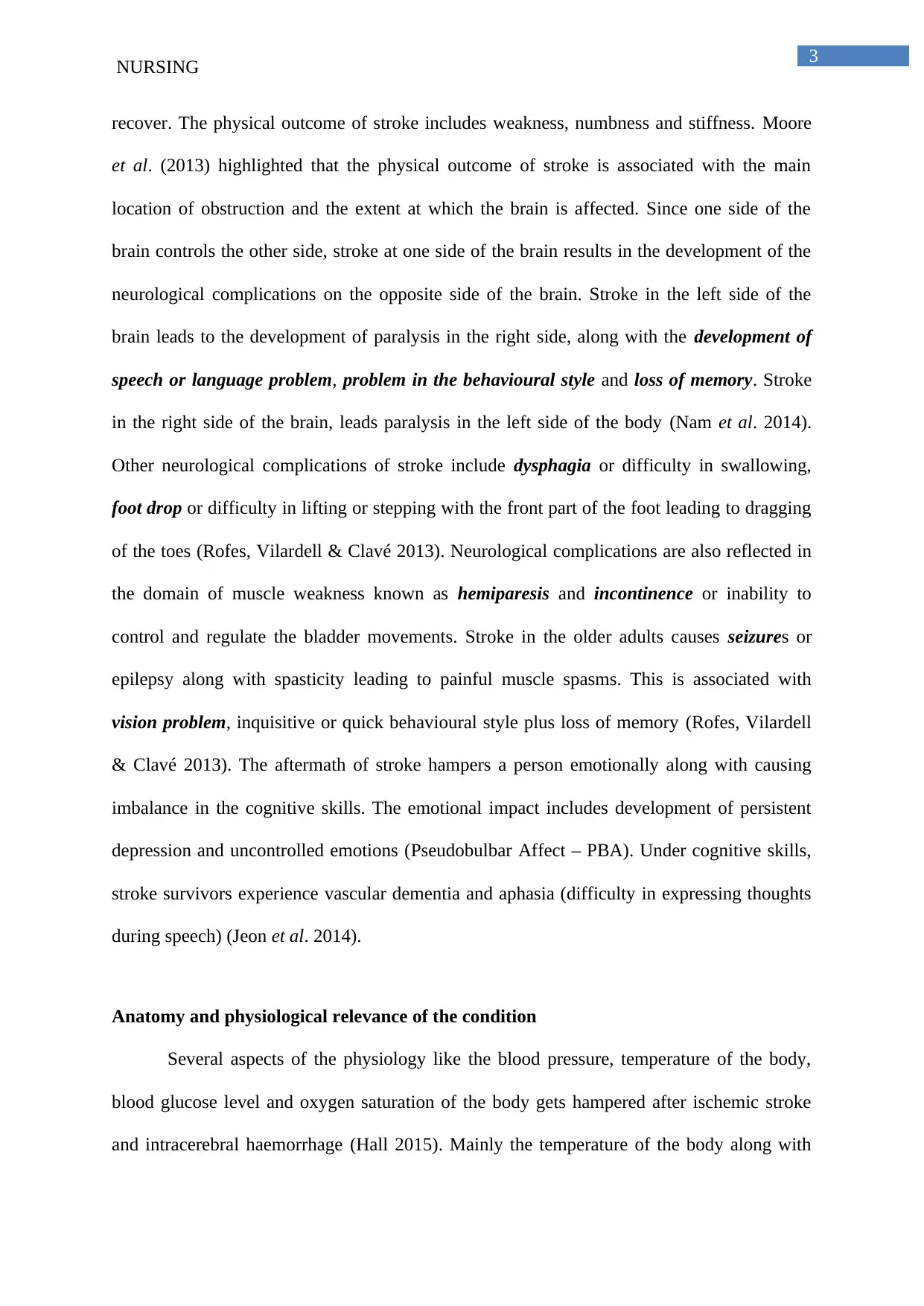
3
NURSING
recover. The physical outcome of stroke includes weakness, numbness and stiffness. Moore
et al. (2013) highlighted that the physical outcome of stroke is associated with the main
location of obstruction and the extent at which the brain is affected. Since one side of the
brain controls the other side, stroke at one side of the brain results in the development of the
neurological complications on the opposite side of the brain. Stroke in the left side of the
brain leads to the development of paralysis in the right side, along with the development of
speech or language problem, problem in the behavioural style and loss of memory. Stroke
in the right side of the brain, leads paralysis in the left side of the body (Nam et al. 2014).
Other neurological complications of stroke include dysphagia or difficulty in swallowing,
foot drop or difficulty in lifting or stepping with the front part of the foot leading to dragging
of the toes (Rofes, Vilardell & Clavé 2013). Neurological complications are also reflected in
the domain of muscle weakness known as hemiparesis and incontinence or inability to
control and regulate the bladder movements. Stroke in the older adults causes seizures or
epilepsy along with spasticity leading to painful muscle spasms. This is associated with
vision problem, inquisitive or quick behavioural style plus loss of memory (Rofes, Vilardell
& Clavé 2013). The aftermath of stroke hampers a person emotionally along with causing
imbalance in the cognitive skills. The emotional impact includes development of persistent
depression and uncontrolled emotions (Pseudobulbar Affect – PBA). Under cognitive skills,
stroke survivors experience vascular dementia and aphasia (difficulty in expressing thoughts
during speech) (Jeon et al. 2014).
Anatomy and physiological relevance of the condition
Several aspects of the physiology like the blood pressure, temperature of the body,
blood glucose level and oxygen saturation of the body gets hampered after ischemic stroke
and intracerebral haemorrhage (Hall 2015). Mainly the temperature of the body along with
NURSING
recover. The physical outcome of stroke includes weakness, numbness and stiffness. Moore
et al. (2013) highlighted that the physical outcome of stroke is associated with the main
location of obstruction and the extent at which the brain is affected. Since one side of the
brain controls the other side, stroke at one side of the brain results in the development of the
neurological complications on the opposite side of the brain. Stroke in the left side of the
brain leads to the development of paralysis in the right side, along with the development of
speech or language problem, problem in the behavioural style and loss of memory. Stroke
in the right side of the brain, leads paralysis in the left side of the body (Nam et al. 2014).
Other neurological complications of stroke include dysphagia or difficulty in swallowing,
foot drop or difficulty in lifting or stepping with the front part of the foot leading to dragging
of the toes (Rofes, Vilardell & Clavé 2013). Neurological complications are also reflected in
the domain of muscle weakness known as hemiparesis and incontinence or inability to
control and regulate the bladder movements. Stroke in the older adults causes seizures or
epilepsy along with spasticity leading to painful muscle spasms. This is associated with
vision problem, inquisitive or quick behavioural style plus loss of memory (Rofes, Vilardell
& Clavé 2013). The aftermath of stroke hampers a person emotionally along with causing
imbalance in the cognitive skills. The emotional impact includes development of persistent
depression and uncontrolled emotions (Pseudobulbar Affect – PBA). Under cognitive skills,
stroke survivors experience vascular dementia and aphasia (difficulty in expressing thoughts
during speech) (Jeon et al. 2014).
Anatomy and physiological relevance of the condition
Several aspects of the physiology like the blood pressure, temperature of the body,
blood glucose level and oxygen saturation of the body gets hampered after ischemic stroke
and intracerebral haemorrhage (Hall 2015). Mainly the temperature of the body along with
Secure Best Marks with AI Grader
Need help grading? Try our AI Grader for instant feedback on your assignments.
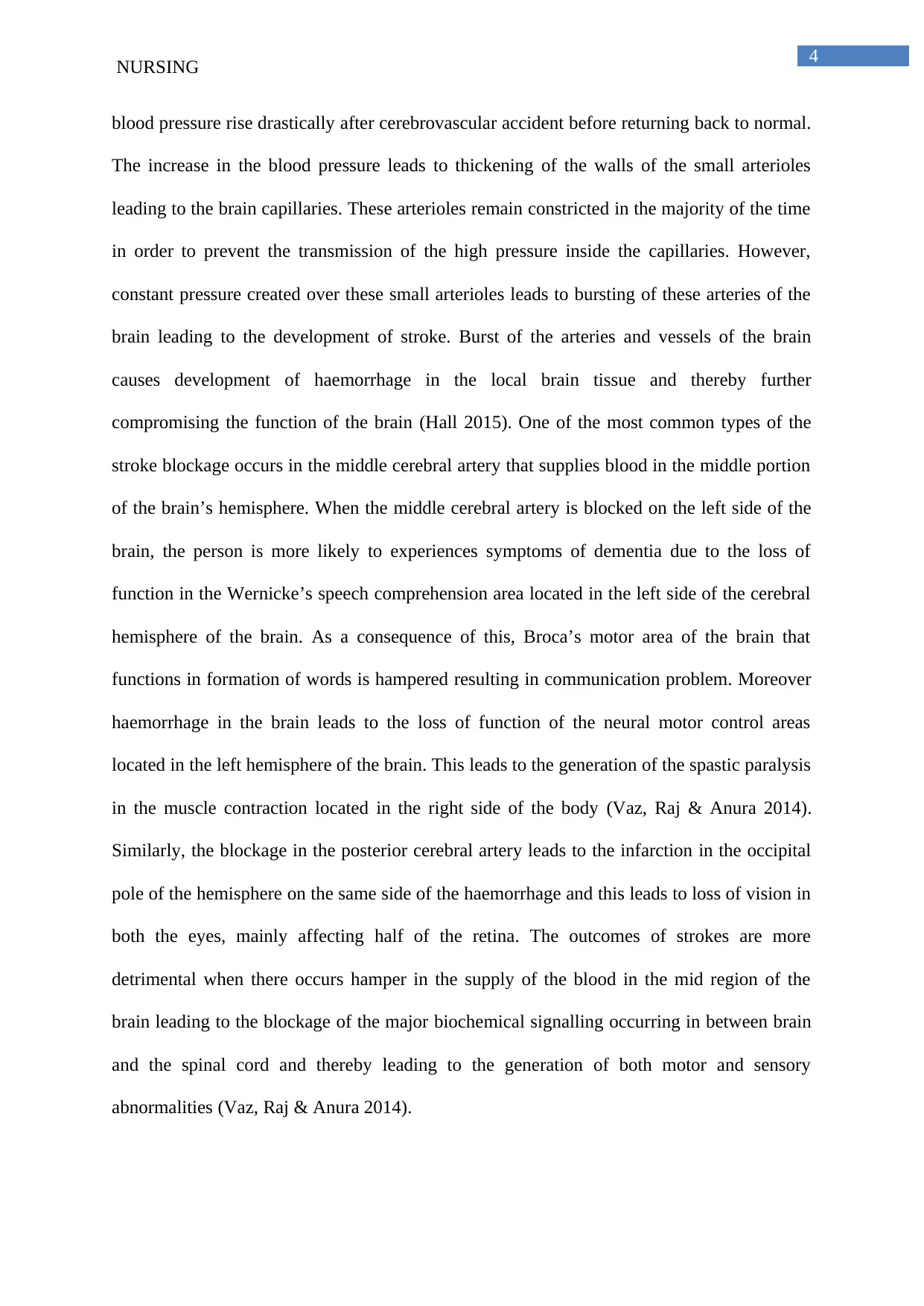
4
NURSING
blood pressure rise drastically after cerebrovascular accident before returning back to normal.
The increase in the blood pressure leads to thickening of the walls of the small arterioles
leading to the brain capillaries. These arterioles remain constricted in the majority of the time
in order to prevent the transmission of the high pressure inside the capillaries. However,
constant pressure created over these small arterioles leads to bursting of these arteries of the
brain leading to the development of stroke. Burst of the arteries and vessels of the brain
causes development of haemorrhage in the local brain tissue and thereby further
compromising the function of the brain (Hall 2015). One of the most common types of the
stroke blockage occurs in the middle cerebral artery that supplies blood in the middle portion
of the brain’s hemisphere. When the middle cerebral artery is blocked on the left side of the
brain, the person is more likely to experiences symptoms of dementia due to the loss of
function in the Wernicke’s speech comprehension area located in the left side of the cerebral
hemisphere of the brain. As a consequence of this, Broca’s motor area of the brain that
functions in formation of words is hampered resulting in communication problem. Moreover
haemorrhage in the brain leads to the loss of function of the neural motor control areas
located in the left hemisphere of the brain. This leads to the generation of the spastic paralysis
in the muscle contraction located in the right side of the body (Vaz, Raj & Anura 2014).
Similarly, the blockage in the posterior cerebral artery leads to the infarction in the occipital
pole of the hemisphere on the same side of the haemorrhage and this leads to loss of vision in
both the eyes, mainly affecting half of the retina. The outcomes of strokes are more
detrimental when there occurs hamper in the supply of the blood in the mid region of the
brain leading to the blockage of the major biochemical signalling occurring in between brain
and the spinal cord and thereby leading to the generation of both motor and sensory
abnormalities (Vaz, Raj & Anura 2014).
NURSING
blood pressure rise drastically after cerebrovascular accident before returning back to normal.
The increase in the blood pressure leads to thickening of the walls of the small arterioles
leading to the brain capillaries. These arterioles remain constricted in the majority of the time
in order to prevent the transmission of the high pressure inside the capillaries. However,
constant pressure created over these small arterioles leads to bursting of these arteries of the
brain leading to the development of stroke. Burst of the arteries and vessels of the brain
causes development of haemorrhage in the local brain tissue and thereby further
compromising the function of the brain (Hall 2015). One of the most common types of the
stroke blockage occurs in the middle cerebral artery that supplies blood in the middle portion
of the brain’s hemisphere. When the middle cerebral artery is blocked on the left side of the
brain, the person is more likely to experiences symptoms of dementia due to the loss of
function in the Wernicke’s speech comprehension area located in the left side of the cerebral
hemisphere of the brain. As a consequence of this, Broca’s motor area of the brain that
functions in formation of words is hampered resulting in communication problem. Moreover
haemorrhage in the brain leads to the loss of function of the neural motor control areas
located in the left hemisphere of the brain. This leads to the generation of the spastic paralysis
in the muscle contraction located in the right side of the body (Vaz, Raj & Anura 2014).
Similarly, the blockage in the posterior cerebral artery leads to the infarction in the occipital
pole of the hemisphere on the same side of the haemorrhage and this leads to loss of vision in
both the eyes, mainly affecting half of the retina. The outcomes of strokes are more
detrimental when there occurs hamper in the supply of the blood in the mid region of the
brain leading to the blockage of the major biochemical signalling occurring in between brain
and the spinal cord and thereby leading to the generation of both motor and sensory
abnormalities (Vaz, Raj & Anura 2014).
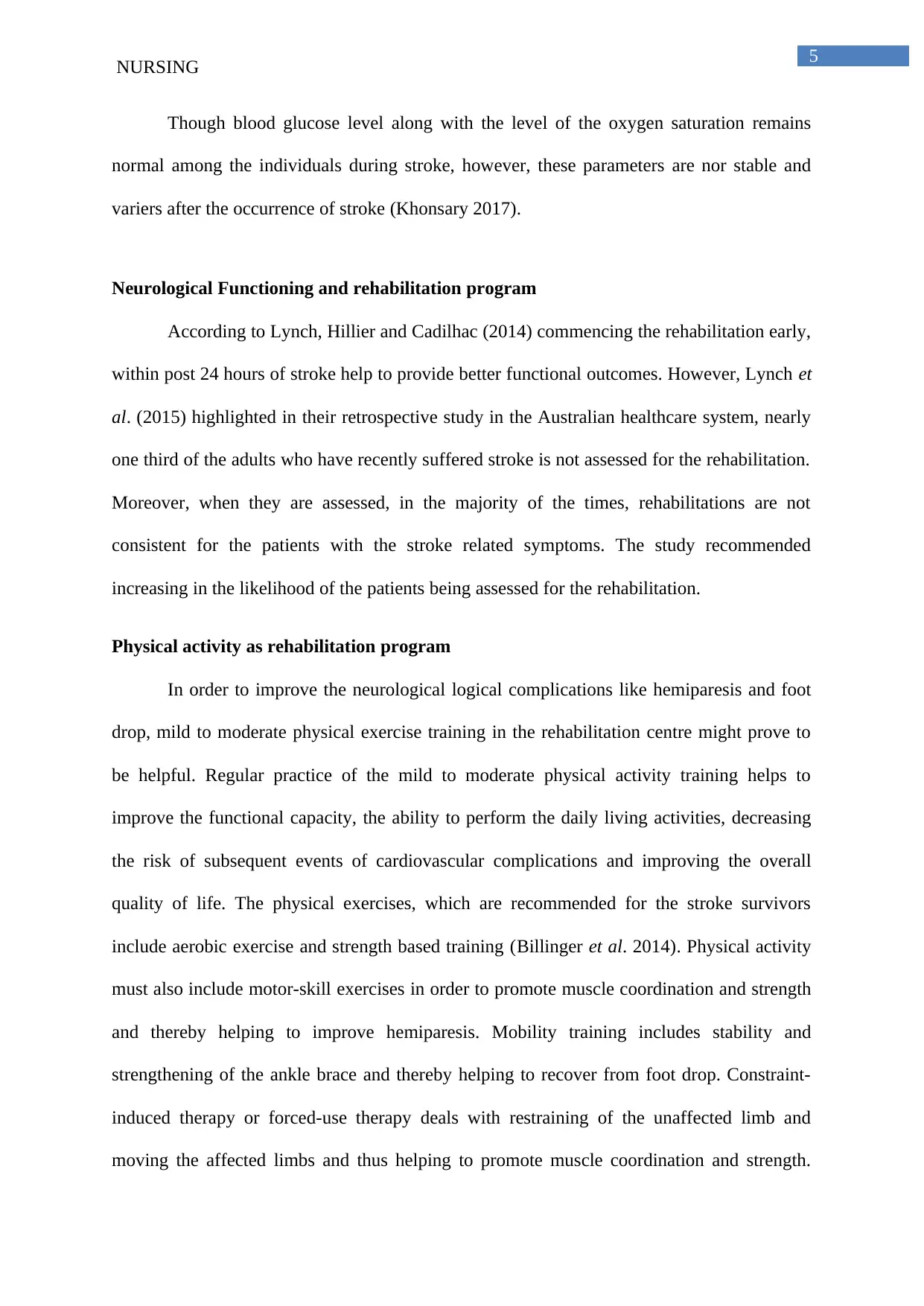
5
NURSING
Though blood glucose level along with the level of the oxygen saturation remains
normal among the individuals during stroke, however, these parameters are nor stable and
variers after the occurrence of stroke (Khonsary 2017).
Neurological Functioning and rehabilitation program
According to Lynch, Hillier and Cadilhac (2014) commencing the rehabilitation early,
within post 24 hours of stroke help to provide better functional outcomes. However, Lynch et
al. (2015) highlighted in their retrospective study in the Australian healthcare system, nearly
one third of the adults who have recently suffered stroke is not assessed for the rehabilitation.
Moreover, when they are assessed, in the majority of the times, rehabilitations are not
consistent for the patients with the stroke related symptoms. The study recommended
increasing in the likelihood of the patients being assessed for the rehabilitation.
Physical activity as rehabilitation program
In order to improve the neurological logical complications like hemiparesis and foot
drop, mild to moderate physical exercise training in the rehabilitation centre might prove to
be helpful. Regular practice of the mild to moderate physical activity training helps to
improve the functional capacity, the ability to perform the daily living activities, decreasing
the risk of subsequent events of cardiovascular complications and improving the overall
quality of life. The physical exercises, which are recommended for the stroke survivors
include aerobic exercise and strength based training (Billinger et al. 2014). Physical activity
must also include motor-skill exercises in order to promote muscle coordination and strength
and thereby helping to improve hemiparesis. Mobility training includes stability and
strengthening of the ankle brace and thereby helping to recover from foot drop. Constraint-
induced therapy or forced-use therapy deals with restraining of the unaffected limb and
moving the affected limbs and thus helping to promote muscle coordination and strength.
NURSING
Though blood glucose level along with the level of the oxygen saturation remains
normal among the individuals during stroke, however, these parameters are nor stable and
variers after the occurrence of stroke (Khonsary 2017).
Neurological Functioning and rehabilitation program
According to Lynch, Hillier and Cadilhac (2014) commencing the rehabilitation early,
within post 24 hours of stroke help to provide better functional outcomes. However, Lynch et
al. (2015) highlighted in their retrospective study in the Australian healthcare system, nearly
one third of the adults who have recently suffered stroke is not assessed for the rehabilitation.
Moreover, when they are assessed, in the majority of the times, rehabilitations are not
consistent for the patients with the stroke related symptoms. The study recommended
increasing in the likelihood of the patients being assessed for the rehabilitation.
Physical activity as rehabilitation program
In order to improve the neurological logical complications like hemiparesis and foot
drop, mild to moderate physical exercise training in the rehabilitation centre might prove to
be helpful. Regular practice of the mild to moderate physical activity training helps to
improve the functional capacity, the ability to perform the daily living activities, decreasing
the risk of subsequent events of cardiovascular complications and improving the overall
quality of life. The physical exercises, which are recommended for the stroke survivors
include aerobic exercise and strength based training (Billinger et al. 2014). Physical activity
must also include motor-skill exercises in order to promote muscle coordination and strength
and thereby helping to improve hemiparesis. Mobility training includes stability and
strengthening of the ankle brace and thereby helping to recover from foot drop. Constraint-
induced therapy or forced-use therapy deals with restraining of the unaffected limb and
moving the affected limbs and thus helping to promote muscle coordination and strength.
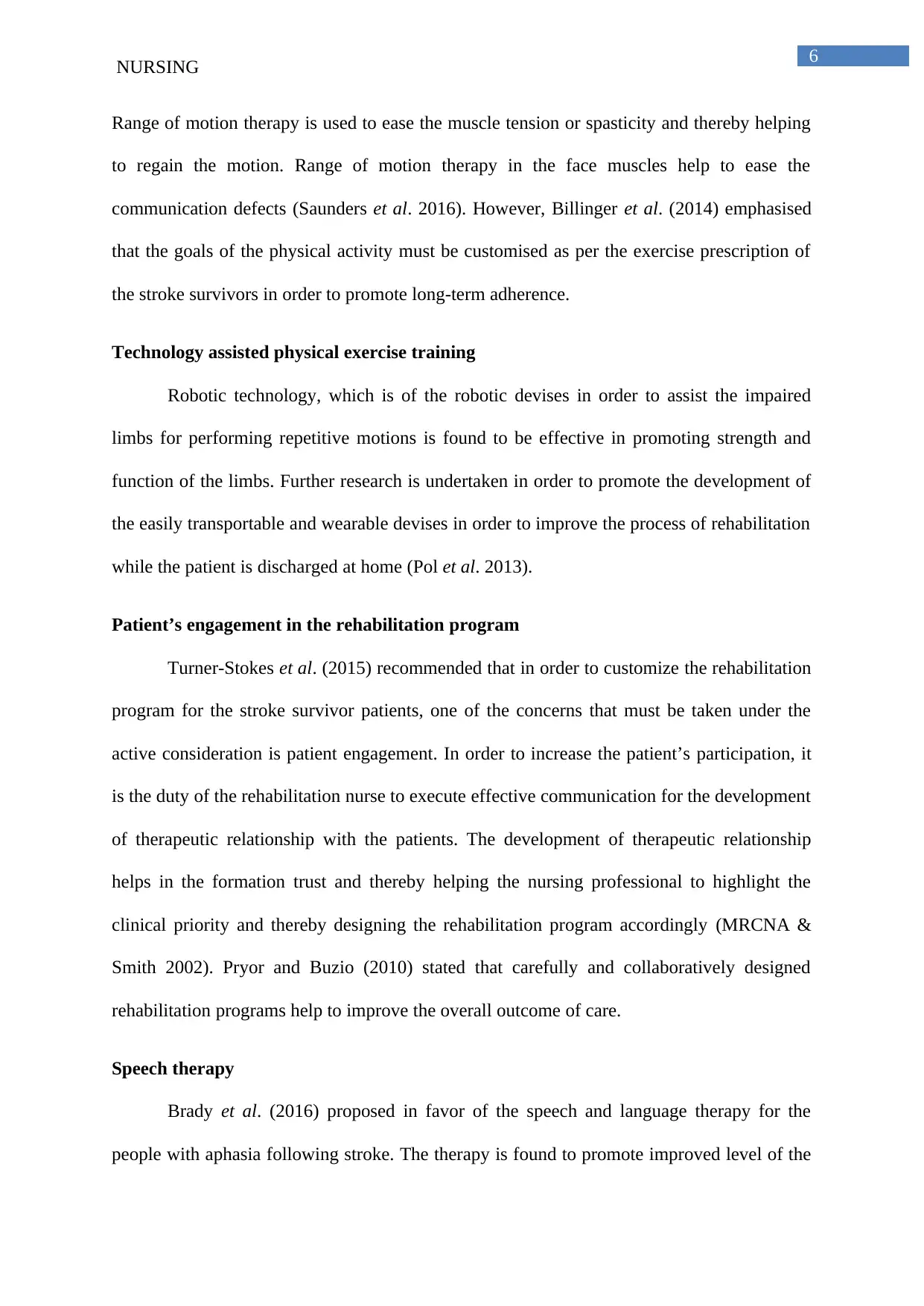
6
NURSING
Range of motion therapy is used to ease the muscle tension or spasticity and thereby helping
to regain the motion. Range of motion therapy in the face muscles help to ease the
communication defects (Saunders et al. 2016). However, Billinger et al. (2014) emphasised
that the goals of the physical activity must be customised as per the exercise prescription of
the stroke survivors in order to promote long-term adherence.
Technology assisted physical exercise training
Robotic technology, which is of the robotic devises in order to assist the impaired
limbs for performing repetitive motions is found to be effective in promoting strength and
function of the limbs. Further research is undertaken in order to promote the development of
the easily transportable and wearable devises in order to improve the process of rehabilitation
while the patient is discharged at home (Pol et al. 2013).
Patient’s engagement in the rehabilitation program
Turner-Stokes et al. (2015) recommended that in order to customize the rehabilitation
program for the stroke survivor patients, one of the concerns that must be taken under the
active consideration is patient engagement. In order to increase the patient’s participation, it
is the duty of the rehabilitation nurse to execute effective communication for the development
of therapeutic relationship with the patients. The development of therapeutic relationship
helps in the formation trust and thereby helping the nursing professional to highlight the
clinical priority and thereby designing the rehabilitation program accordingly (MRCNA &
Smith 2002). Pryor and Buzio (2010) stated that carefully and collaboratively designed
rehabilitation programs help to improve the overall outcome of care.
Speech therapy
Brady et al. (2016) proposed in favor of the speech and language therapy for the
people with aphasia following stroke. The therapy is found to promote improved level of the
NURSING
Range of motion therapy is used to ease the muscle tension or spasticity and thereby helping
to regain the motion. Range of motion therapy in the face muscles help to ease the
communication defects (Saunders et al. 2016). However, Billinger et al. (2014) emphasised
that the goals of the physical activity must be customised as per the exercise prescription of
the stroke survivors in order to promote long-term adherence.
Technology assisted physical exercise training
Robotic technology, which is of the robotic devises in order to assist the impaired
limbs for performing repetitive motions is found to be effective in promoting strength and
function of the limbs. Further research is undertaken in order to promote the development of
the easily transportable and wearable devises in order to improve the process of rehabilitation
while the patient is discharged at home (Pol et al. 2013).
Patient’s engagement in the rehabilitation program
Turner-Stokes et al. (2015) recommended that in order to customize the rehabilitation
program for the stroke survivor patients, one of the concerns that must be taken under the
active consideration is patient engagement. In order to increase the patient’s participation, it
is the duty of the rehabilitation nurse to execute effective communication for the development
of therapeutic relationship with the patients. The development of therapeutic relationship
helps in the formation trust and thereby helping the nursing professional to highlight the
clinical priority and thereby designing the rehabilitation program accordingly (MRCNA &
Smith 2002). Pryor and Buzio (2010) stated that carefully and collaboratively designed
rehabilitation programs help to improve the overall outcome of care.
Speech therapy
Brady et al. (2016) proposed in favor of the speech and language therapy for the
people with aphasia following stroke. The therapy is found to promote improved level of the
Paraphrase This Document
Need a fresh take? Get an instant paraphrase of this document with our AI Paraphraser
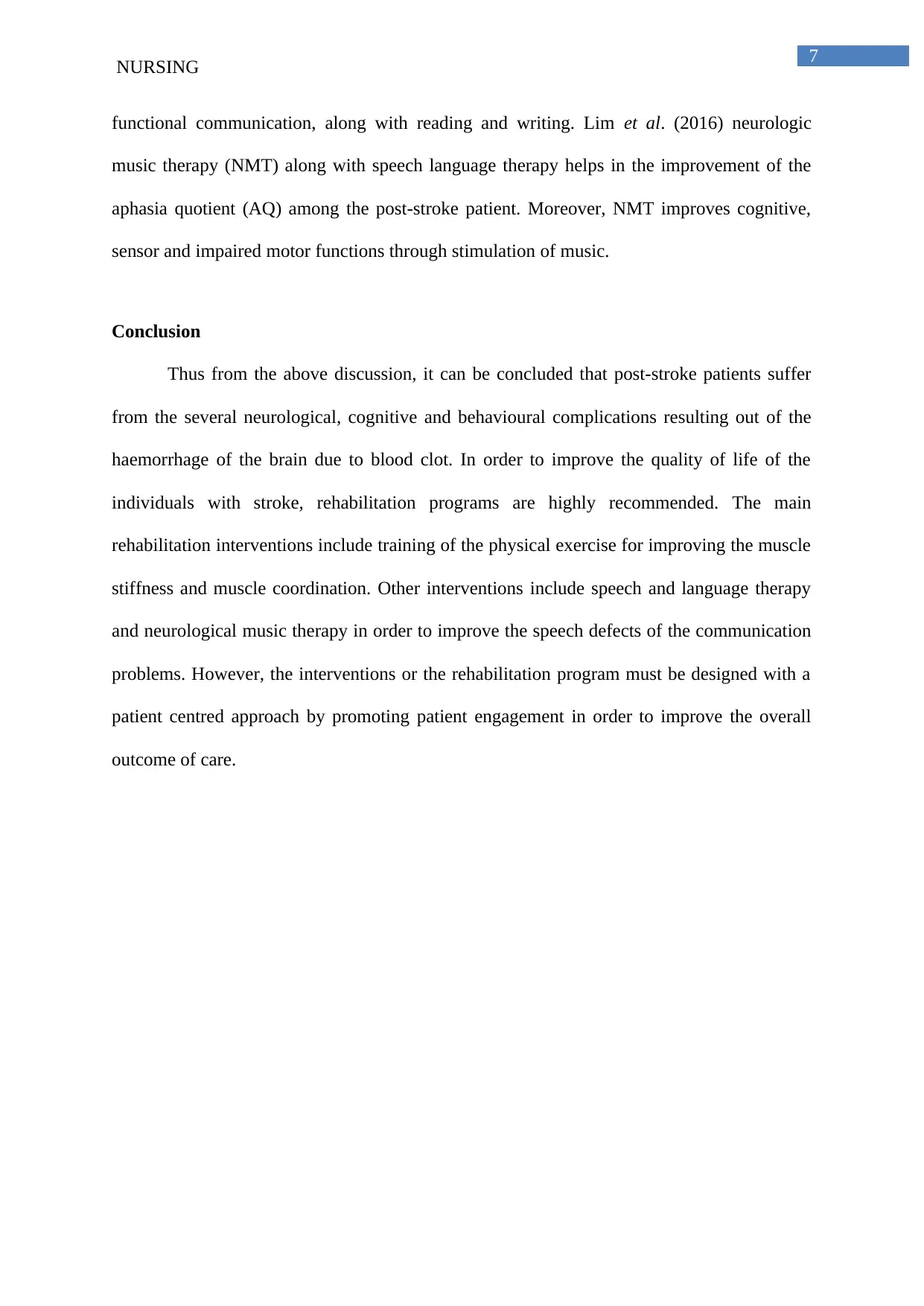
7
NURSING
functional communication, along with reading and writing. Lim et al. (2016) neurologic
music therapy (NMT) along with speech language therapy helps in the improvement of the
aphasia quotient (AQ) among the post-stroke patient. Moreover, NMT improves cognitive,
sensor and impaired motor functions through stimulation of music.
Conclusion
Thus from the above discussion, it can be concluded that post-stroke patients suffer
from the several neurological, cognitive and behavioural complications resulting out of the
haemorrhage of the brain due to blood clot. In order to improve the quality of life of the
individuals with stroke, rehabilitation programs are highly recommended. The main
rehabilitation interventions include training of the physical exercise for improving the muscle
stiffness and muscle coordination. Other interventions include speech and language therapy
and neurological music therapy in order to improve the speech defects of the communication
problems. However, the interventions or the rehabilitation program must be designed with a
patient centred approach by promoting patient engagement in order to improve the overall
outcome of care.
NURSING
functional communication, along with reading and writing. Lim et al. (2016) neurologic
music therapy (NMT) along with speech language therapy helps in the improvement of the
aphasia quotient (AQ) among the post-stroke patient. Moreover, NMT improves cognitive,
sensor and impaired motor functions through stimulation of music.
Conclusion
Thus from the above discussion, it can be concluded that post-stroke patients suffer
from the several neurological, cognitive and behavioural complications resulting out of the
haemorrhage of the brain due to blood clot. In order to improve the quality of life of the
individuals with stroke, rehabilitation programs are highly recommended. The main
rehabilitation interventions include training of the physical exercise for improving the muscle
stiffness and muscle coordination. Other interventions include speech and language therapy
and neurological music therapy in order to improve the speech defects of the communication
problems. However, the interventions or the rehabilitation program must be designed with a
patient centred approach by promoting patient engagement in order to improve the overall
outcome of care.
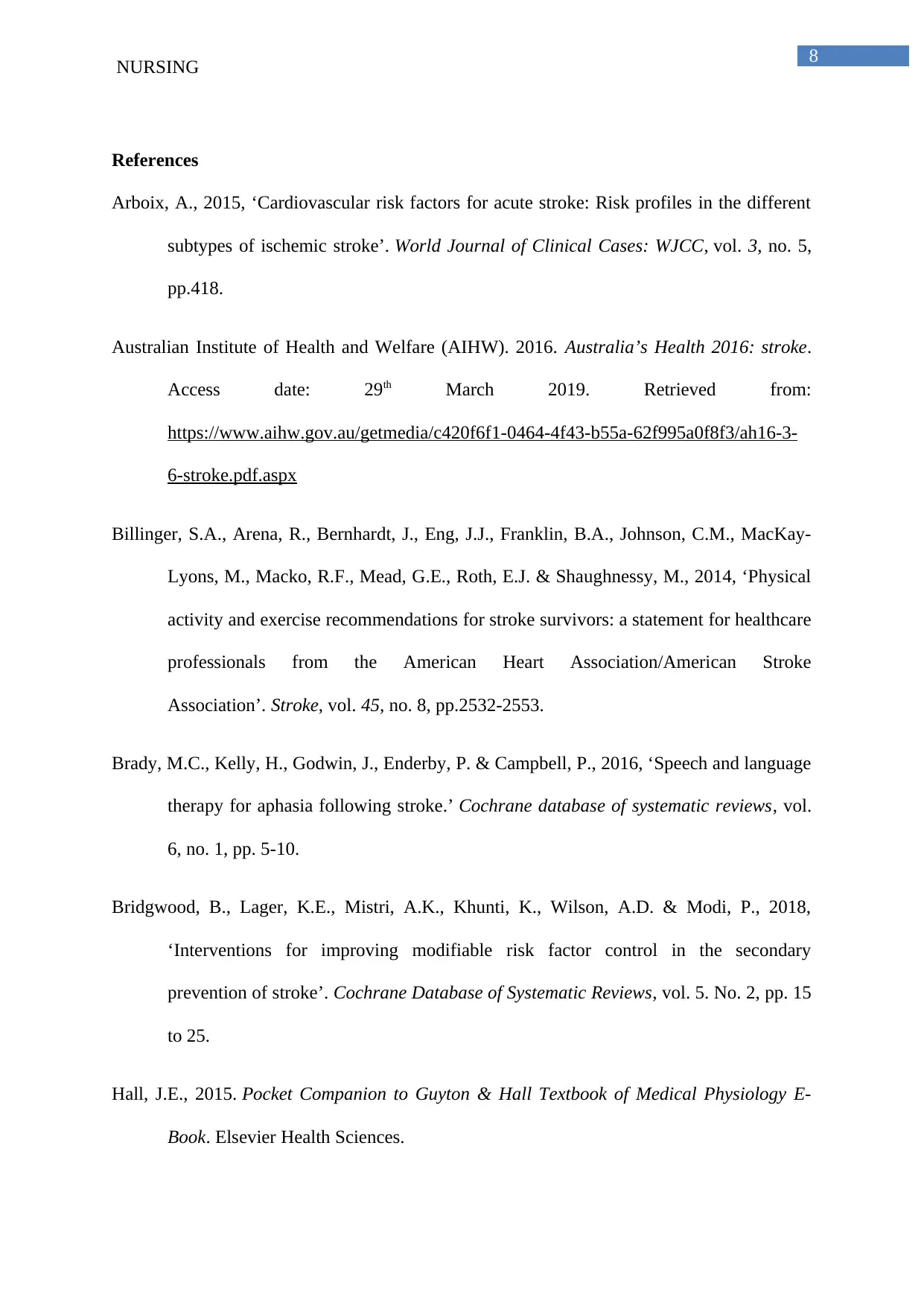
8
NURSING
References
Arboix, A., 2015, ‘Cardiovascular risk factors for acute stroke: Risk profiles in the different
subtypes of ischemic stroke’. World Journal of Clinical Cases: WJCC, vol. 3, no. 5,
pp.418.
Australian Institute of Health and Welfare (AIHW). 2016. Australia’s Health 2016: stroke.
Access date: 29th March 2019. Retrieved from:
https://www.aihw.gov.au/getmedia/c420f6f1-0464-4f43-b55a-62f995a0f8f3/ah16-3-
6-stroke.pdf.aspx
Billinger, S.A., Arena, R., Bernhardt, J., Eng, J.J., Franklin, B.A., Johnson, C.M., MacKay-
Lyons, M., Macko, R.F., Mead, G.E., Roth, E.J. & Shaughnessy, M., 2014, ‘Physical
activity and exercise recommendations for stroke survivors: a statement for healthcare
professionals from the American Heart Association/American Stroke
Association’. Stroke, vol. 45, no. 8, pp.2532-2553.
Brady, M.C., Kelly, H., Godwin, J., Enderby, P. & Campbell, P., 2016, ‘Speech and language
therapy for aphasia following stroke.’ Cochrane database of systematic reviews, vol.
6, no. 1, pp. 5-10.
Bridgwood, B., Lager, K.E., Mistri, A.K., Khunti, K., Wilson, A.D. & Modi, P., 2018,
‘Interventions for improving modifiable risk factor control in the secondary
prevention of stroke’. Cochrane Database of Systematic Reviews, vol. 5. No. 2, pp. 15
to 25.
Hall, J.E., 2015. Pocket Companion to Guyton & Hall Textbook of Medical Physiology E-
Book. Elsevier Health Sciences.
NURSING
References
Arboix, A., 2015, ‘Cardiovascular risk factors for acute stroke: Risk profiles in the different
subtypes of ischemic stroke’. World Journal of Clinical Cases: WJCC, vol. 3, no. 5,
pp.418.
Australian Institute of Health and Welfare (AIHW). 2016. Australia’s Health 2016: stroke.
Access date: 29th March 2019. Retrieved from:
https://www.aihw.gov.au/getmedia/c420f6f1-0464-4f43-b55a-62f995a0f8f3/ah16-3-
6-stroke.pdf.aspx
Billinger, S.A., Arena, R., Bernhardt, J., Eng, J.J., Franklin, B.A., Johnson, C.M., MacKay-
Lyons, M., Macko, R.F., Mead, G.E., Roth, E.J. & Shaughnessy, M., 2014, ‘Physical
activity and exercise recommendations for stroke survivors: a statement for healthcare
professionals from the American Heart Association/American Stroke
Association’. Stroke, vol. 45, no. 8, pp.2532-2553.
Brady, M.C., Kelly, H., Godwin, J., Enderby, P. & Campbell, P., 2016, ‘Speech and language
therapy for aphasia following stroke.’ Cochrane database of systematic reviews, vol.
6, no. 1, pp. 5-10.
Bridgwood, B., Lager, K.E., Mistri, A.K., Khunti, K., Wilson, A.D. & Modi, P., 2018,
‘Interventions for improving modifiable risk factor control in the secondary
prevention of stroke’. Cochrane Database of Systematic Reviews, vol. 5. No. 2, pp. 15
to 25.
Hall, J.E., 2015. Pocket Companion to Guyton & Hall Textbook of Medical Physiology E-
Book. Elsevier Health Sciences.
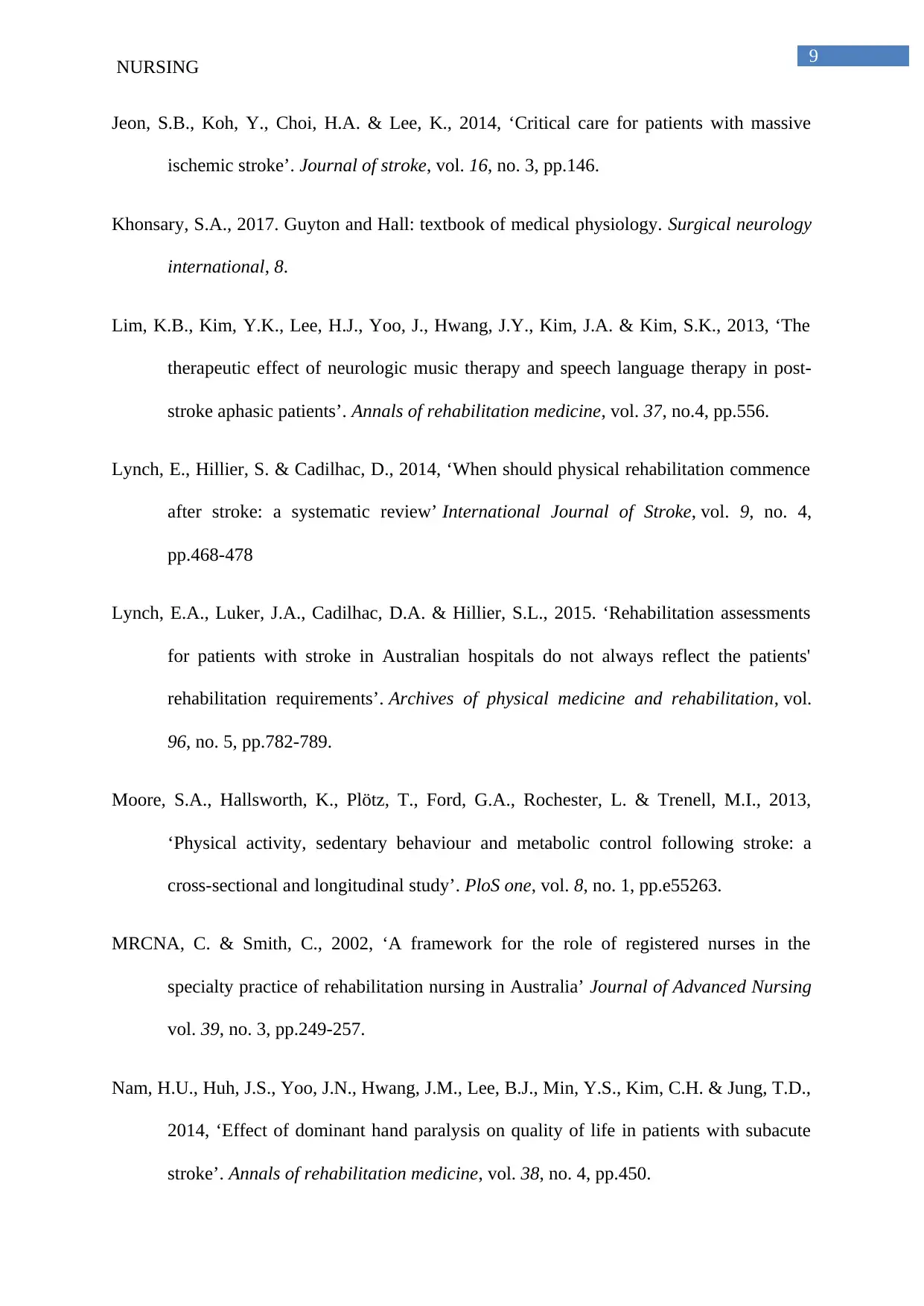
9
NURSING
Jeon, S.B., Koh, Y., Choi, H.A. & Lee, K., 2014, ‘Critical care for patients with massive
ischemic stroke’. Journal of stroke, vol. 16, no. 3, pp.146.
Khonsary, S.A., 2017. Guyton and Hall: textbook of medical physiology. Surgical neurology
international, 8.
Lim, K.B., Kim, Y.K., Lee, H.J., Yoo, J., Hwang, J.Y., Kim, J.A. & Kim, S.K., 2013, ‘The
therapeutic effect of neurologic music therapy and speech language therapy in post-
stroke aphasic patients’. Annals of rehabilitation medicine, vol. 37, no.4, pp.556.
Lynch, E., Hillier, S. & Cadilhac, D., 2014, ‘When should physical rehabilitation commence
after stroke: a systematic review’ International Journal of Stroke, vol. 9, no. 4,
pp.468-478
Lynch, E.A., Luker, J.A., Cadilhac, D.A. & Hillier, S.L., 2015. ‘Rehabilitation assessments
for patients with stroke in Australian hospitals do not always reflect the patients'
rehabilitation requirements’. Archives of physical medicine and rehabilitation, vol.
96, no. 5, pp.782-789.
Moore, S.A., Hallsworth, K., Plötz, T., Ford, G.A., Rochester, L. & Trenell, M.I., 2013,
‘Physical activity, sedentary behaviour and metabolic control following stroke: a
cross-sectional and longitudinal study’. PloS one, vol. 8, no. 1, pp.e55263.
MRCNA, C. & Smith, C., 2002, ‘A framework for the role of registered nurses in the
specialty practice of rehabilitation nursing in Australia’ Journal of Advanced Nursing
vol. 39, no. 3, pp.249-257.
Nam, H.U., Huh, J.S., Yoo, J.N., Hwang, J.M., Lee, B.J., Min, Y.S., Kim, C.H. & Jung, T.D.,
2014, ‘Effect of dominant hand paralysis on quality of life in patients with subacute
stroke’. Annals of rehabilitation medicine, vol. 38, no. 4, pp.450.
NURSING
Jeon, S.B., Koh, Y., Choi, H.A. & Lee, K., 2014, ‘Critical care for patients with massive
ischemic stroke’. Journal of stroke, vol. 16, no. 3, pp.146.
Khonsary, S.A., 2017. Guyton and Hall: textbook of medical physiology. Surgical neurology
international, 8.
Lim, K.B., Kim, Y.K., Lee, H.J., Yoo, J., Hwang, J.Y., Kim, J.A. & Kim, S.K., 2013, ‘The
therapeutic effect of neurologic music therapy and speech language therapy in post-
stroke aphasic patients’. Annals of rehabilitation medicine, vol. 37, no.4, pp.556.
Lynch, E., Hillier, S. & Cadilhac, D., 2014, ‘When should physical rehabilitation commence
after stroke: a systematic review’ International Journal of Stroke, vol. 9, no. 4,
pp.468-478
Lynch, E.A., Luker, J.A., Cadilhac, D.A. & Hillier, S.L., 2015. ‘Rehabilitation assessments
for patients with stroke in Australian hospitals do not always reflect the patients'
rehabilitation requirements’. Archives of physical medicine and rehabilitation, vol.
96, no. 5, pp.782-789.
Moore, S.A., Hallsworth, K., Plötz, T., Ford, G.A., Rochester, L. & Trenell, M.I., 2013,
‘Physical activity, sedentary behaviour and metabolic control following stroke: a
cross-sectional and longitudinal study’. PloS one, vol. 8, no. 1, pp.e55263.
MRCNA, C. & Smith, C., 2002, ‘A framework for the role of registered nurses in the
specialty practice of rehabilitation nursing in Australia’ Journal of Advanced Nursing
vol. 39, no. 3, pp.249-257.
Nam, H.U., Huh, J.S., Yoo, J.N., Hwang, J.M., Lee, B.J., Min, Y.S., Kim, C.H. & Jung, T.D.,
2014, ‘Effect of dominant hand paralysis on quality of life in patients with subacute
stroke’. Annals of rehabilitation medicine, vol. 38, no. 4, pp.450.
Secure Best Marks with AI Grader
Need help grading? Try our AI Grader for instant feedback on your assignments.
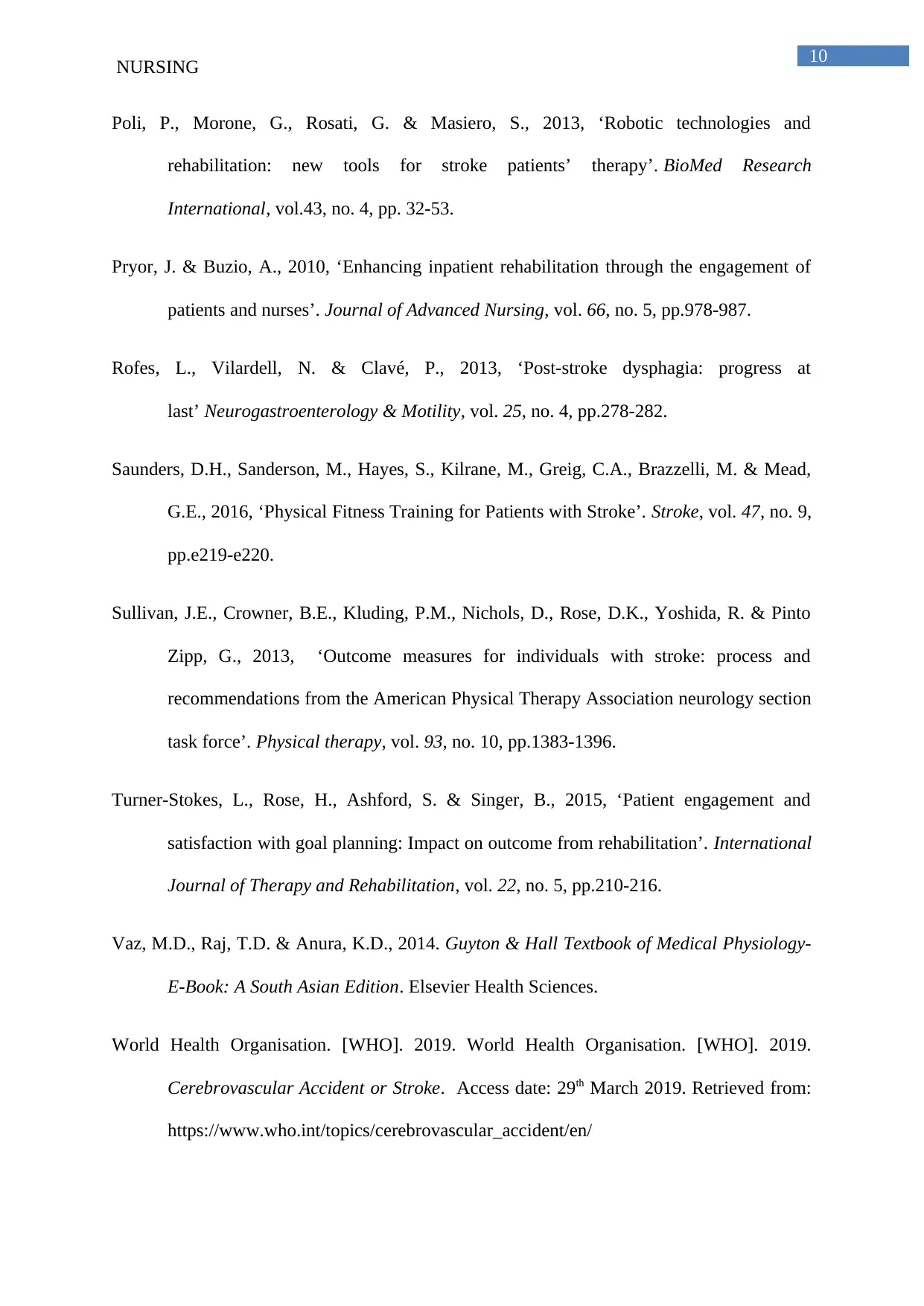
10
NURSING
Poli, P., Morone, G., Rosati, G. & Masiero, S., 2013, ‘Robotic technologies and
rehabilitation: new tools for stroke patients’ therapy’. BioMed Research
International, vol.43, no. 4, pp. 32-53.
Pryor, J. & Buzio, A., 2010, ‘Enhancing inpatient rehabilitation through the engagement of
patients and nurses’. Journal of Advanced Nursing, vol. 66, no. 5, pp.978-987.
Rofes, L., Vilardell, N. & Clavé, P., 2013, ‘Post‐stroke dysphagia: progress at
last’ Neurogastroenterology & Motility, vol. 25, no. 4, pp.278-282.
Saunders, D.H., Sanderson, M., Hayes, S., Kilrane, M., Greig, C.A., Brazzelli, M. & Mead,
G.E., 2016, ‘Physical Fitness Training for Patients with Stroke’. Stroke, vol. 47, no. 9,
pp.e219-e220.
Sullivan, J.E., Crowner, B.E., Kluding, P.M., Nichols, D., Rose, D.K., Yoshida, R. & Pinto
Zipp, G., 2013, ‘Outcome measures for individuals with stroke: process and
recommendations from the American Physical Therapy Association neurology section
task force’. Physical therapy, vol. 93, no. 10, pp.1383-1396.
Turner-Stokes, L., Rose, H., Ashford, S. & Singer, B., 2015, ‘Patient engagement and
satisfaction with goal planning: Impact on outcome from rehabilitation’. International
Journal of Therapy and Rehabilitation, vol. 22, no. 5, pp.210-216.
Vaz, M.D., Raj, T.D. & Anura, K.D., 2014. Guyton & Hall Textbook of Medical Physiology-
E-Book: A South Asian Edition. Elsevier Health Sciences.
World Health Organisation. [WHO]. 2019. World Health Organisation. [WHO]. 2019.
Cerebrovascular Accident or Stroke. Access date: 29th March 2019. Retrieved from:
https://www.who.int/topics/cerebrovascular_accident/en/
NURSING
Poli, P., Morone, G., Rosati, G. & Masiero, S., 2013, ‘Robotic technologies and
rehabilitation: new tools for stroke patients’ therapy’. BioMed Research
International, vol.43, no. 4, pp. 32-53.
Pryor, J. & Buzio, A., 2010, ‘Enhancing inpatient rehabilitation through the engagement of
patients and nurses’. Journal of Advanced Nursing, vol. 66, no. 5, pp.978-987.
Rofes, L., Vilardell, N. & Clavé, P., 2013, ‘Post‐stroke dysphagia: progress at
last’ Neurogastroenterology & Motility, vol. 25, no. 4, pp.278-282.
Saunders, D.H., Sanderson, M., Hayes, S., Kilrane, M., Greig, C.A., Brazzelli, M. & Mead,
G.E., 2016, ‘Physical Fitness Training for Patients with Stroke’. Stroke, vol. 47, no. 9,
pp.e219-e220.
Sullivan, J.E., Crowner, B.E., Kluding, P.M., Nichols, D., Rose, D.K., Yoshida, R. & Pinto
Zipp, G., 2013, ‘Outcome measures for individuals with stroke: process and
recommendations from the American Physical Therapy Association neurology section
task force’. Physical therapy, vol. 93, no. 10, pp.1383-1396.
Turner-Stokes, L., Rose, H., Ashford, S. & Singer, B., 2015, ‘Patient engagement and
satisfaction with goal planning: Impact on outcome from rehabilitation’. International
Journal of Therapy and Rehabilitation, vol. 22, no. 5, pp.210-216.
Vaz, M.D., Raj, T.D. & Anura, K.D., 2014. Guyton & Hall Textbook of Medical Physiology-
E-Book: A South Asian Edition. Elsevier Health Sciences.
World Health Organisation. [WHO]. 2019. World Health Organisation. [WHO]. 2019.
Cerebrovascular Accident or Stroke. Access date: 29th March 2019. Retrieved from:
https://www.who.int/topics/cerebrovascular_accident/en/
1 out of 11
Related Documents
Your All-in-One AI-Powered Toolkit for Academic Success.
+13062052269
info@desklib.com
Available 24*7 on WhatsApp / Email
![[object Object]](/_next/static/media/star-bottom.7253800d.svg)
Unlock your academic potential
© 2024 | Zucol Services PVT LTD | All rights reserved.





